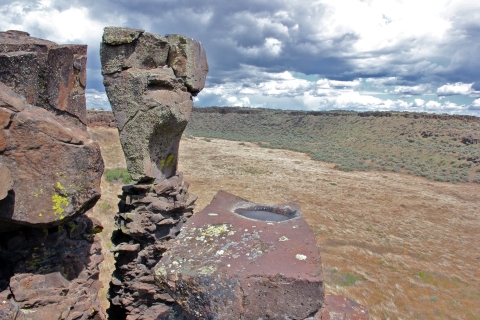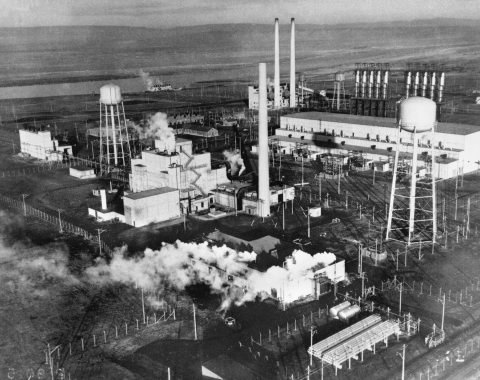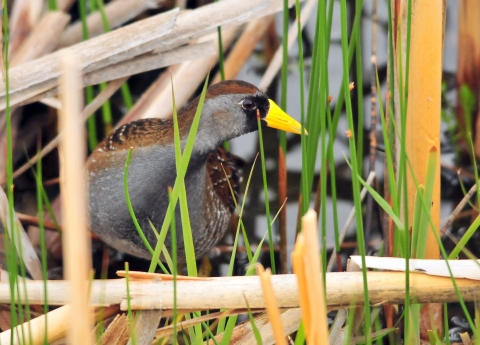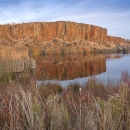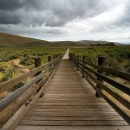Visit Us
Much of Conboy Lake is closed to public access to protect its rare and precious wildlife. However, many interesting parts are open. Please take a moment to orient yourself as to what is open and what is closed, and please follow all closures and regulations in order to protect the refuge's fragile wildlife and plants.
Hours Determined by the Sun
The areas of Conboy Lake open to general public use are open from sunrise to sunset every day. (Hunting has special hours and access. Please visit our Rules & Regulations page for specific information.)
Conditions Vary by Season
Winter in the Cascades can be severe. However, if you visit any other time of the year there are no special precautions needed as the climate and terrain is not extreme. Carry water, dress in layers, let someone know where you're going and when you'll be back, respect the wildlife and you'll be guaranteed a pleasant visit. None of the areas open to public use would be considered backcountry, and facilities are never more than a few minutes away, although there may not be staff around.
Road Conditions and Parking
Speaking of facilities . . . The road into the refuge is gravel, but in excellent shape. County roads are in good repair. In fact, refuge roads and county roads are great places to observe wildlife—just be sure you use common sense and follow traffic laws. The Willard Springs Trail is an easy two-mile hike with a moderate grade, and a wildlife observation platform is located on the trail. Access to the trail, parking and restrooms are available at the refuge headquarters.
Directions from Glenwood
From Glenwood, head west on Main Street for about a third of a mile. As the road begins to curve follow the it to the left onto Draper Springs/Trout Lake Highway. Go 4.8 miles further to the marked entrance on your left for Conboy Lake National Wildlife Refuge. The parking area will be a mile ahead of you.
Directions from White Salmon
White Salmon, Washington, head west on State Route 14 (Lewis and Clark Highway). Turn right onto State Route 141 (Washington 141 Alternate North). After 2.2 miles, turn left onto State Route 141 North. Follow this for about 7.9 miles and turn right onto Glenwood Road. In about 1 mile Glenwood Road turns into the BZ-Glenwood Highway; follow this for another 8.1 miles and turn left onto Laurel Road. In 3.5 miles turn right onto Trout Lake-Greenwood Road. In another mile, turn right into the marked entrance for Conboy Lake National Wildlife Refuge. The parking area will be a mile ahead of you.
Other Facilities in the Complex
The four refuges that make up the Central Washington National Wildlife Refuge Complex have little in common, other than being in the state of Washington. That makes the Complex a wonderfully diverse blend of habitats, species, and recreational opportunities. There’s something to be found by everyone that will pique their interest or pull them into the landscape. A geology buff? Visit Columbia National Wildlife Refuge, carved by the great floods of the last ice age. Need a scenic landscape to paint or simply unwind in? Conboy Lake is the spot. Interested in our history? The Hanford Reach National Monument is the place to investigate. Want to add to your birding life list? Check the spring and fall migrations through Toppenish.
Columbia National Wildlife Refuge
Columbia National Wildlife Refuge is a scenic mixture of rugged cliffs, canyons, lakes, grasslands, and sagebrush sagebrush
The western United States’ sagebrush country encompasses over 175 million acres of public and private lands. The sagebrush landscape provides many benefits to our rural economies and communities, and it serves as crucial habitat for a diversity of wildlife, including the iconic greater sage-grouse and over 350 other species.
Learn more about sagebrush . The mix of lakes, carved by unimaginable floods during the last ice age, and surrounding irrigated croplands, a result Grand Coulee Dam and the Columbia Basin Irrigation Project, combined with generally mild winters and the protection provided by the refuge, attracts large numbers of migrating and wintering mallards, Canada geese, tundra swans, and other waterfowl. As winter turns to spring and frozen lakes begin to thaw, additional waterfowl return in great numbers. The largest concentrations of ducks, geese, and lesser Sandhill cranes arrive on the refuge in March and April, at times numbering over 75,000 individuals. The arrival of the cranes and other waterfowl draw visitors from all over the region, centering around the annual Othello Sandhill Crane Festival.
Hanford Reach National Monument
Thousands of acres of land along the Hanford Reach of the Columbia River and the Saddle Mountain National Wildlife Refuge became the Hanford Reach National Monument in 2000 to protect rare plants, wildlife, and remnants of human history. The 196,000-acre Monument is open, treeless country punctuated by steep rolling hills and canyons. Since 1943, what are now Monument lands have been a safe haven for important and increasingly scarce natural and cultural resources. The lands were allowed to remain wild because they served as a security buffer for the top-secret Manhattan Project during World War II, which produced plutonium for atomic weapons. With limited development and grazing, native plants and animals thrived, and a diverse archaeological record has been preserved. The Monument supports 725 vascular plant species—at least 47 of which are species of conservation concern—42 species of mammals, more than 200 species of birds, 9 reptile and 4 amphibian species, 45 species of fish, and over 1,600 species of insects.
Toppenish National Wildlife Refuge
Toppenish National Wildlife Refuge, established in 1964, is an important link in the chain of feeding and resting areas for waterfowl and other migratory birds using the Pacific Flyway. Although Toppenish was established primarily for migratory waterfowl, many other migratory and resident wildlife species live here, such as American bitterns, peregrine falcons, badgers and beavers. The refuge is a broad collection of habitats supporting a diversity of species. Natural wetlands, such as sloughs and oxbows, and artificial wetlands are flanked by riparian riparian
Definition of riparian habitat or riparian areas.
Learn more about riparian areas. Many species of migratory waterfowl and nongame birds, such as Virginia rails and savannah sparrows, use the wetlands for feeding and nesting activities. Native shrub-steppe—characterized by greasewood, Wyoming big sage, rabbitbrushes, bitterbrush, and native bunchgrasses, such as Great Basin wildrye, Indian ricegrass, Idaho fescue, and Sandberg bluegrass—once covered the upland areas. Loggerhead shrikes, long-billed curlews, California quail, Brewer’s and sage sparrows, and sage thrashers are only some of the animals that use the shrub-steppe. This diverse combination of habitats is a natural magnet to migratory and resident wildlife, alike.
Rules and Policies
Firearms
Firearms and other weapons are subject to state law. At all times, persons possessing, transporting, or carrying firearms on the refuge must comply with all provisions of state law. Firearms may only be discharged in accordance with refuge hunting regulations, i.e., only during the lawful pursuit of game during legal seasons.
Prohibited Activities
The refuge is open for day use only, sunrise to sunset; no overnight parking or camping is allowed. Camping is available at Glenwood and Trout Lake.
The use of unmanned aircraft or drones on the refuge is prohibited.
Other prohibitions on the refuge are dogs off-leash; off-road vehicles; and collecting of plants, animals, minerals, antlers and artifacts.
Hunting
Hunting of some bird species is permitted on the refuge during the regular Washington State hunting seasons in public hunting areas designated on the refuge map. All other species are protected, e.g., elk, deer, upland birds, turkeys, coyotes, cougars, crows, squirrels and rabbits.
No trapping of any kind is allowed on Conboy Lake NWR.
For the current regulations related to hunting on Conboy Lake NWR, please visit www.fws.gov/mcriver/regulations/.




